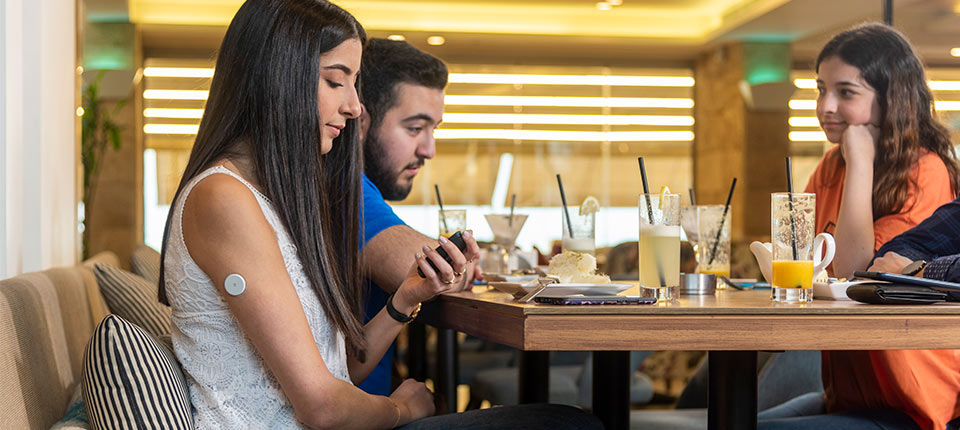
Diabetes Distress: It’s Not All About the Numbers
Why a holistic approach to chronic condition management is vital to long-term success.
Dec. 09, 2022
- Copy Link
- Share on X
- Share on Facebook
- Share on Linkedin
To the casual observer, diabetes management may seem like a numbers game.
And, in fact, the importance of keeping one's glucose levels within a prescribed range can't be overstated, so staying on top of that data is vital.
As the developers of the FreeStyle Libre technology, a continuous glucose monitoring (CGM) system — devices that provide accurate glucose readings1 and insights into where glucose levels have been, are now and where they may be headed — we are all about the numbers.
Trust us. Those glucose numbers — those true, ongoing, insight-revealing numbers — are our focus, our North Star, our raison d’être.
We value the numbers. And those numbers are necessarily a part of the story for every person with diabetes.
But numbers aren't their whole story.
Distressful Thinking
Because living with a chronic condition means the stress-filled, responsibility-laden routine that many people have every day is just the starting line for those with diabetes.
Then tack on always needing to know what your glucose levels are. And what you're going to be eating. And when, ensuring you have the right snacks nearby. Don't neglect to consider how the day's activities may impact glucose levels, how your condition may impact others, what needs to be done in case levels fall.
The constant challenges become obvious.
This feeling has a name: Diabetes distress.
It refers to, "the stresses and strains, tough thoughts and feelings that go along with worries of people with the condition, as they struggle to manage it over time," said Dr. Susan Guzman, co-founder and director of clinical education at the Behavioral Diabetes Institute (BDI).
Managing diabetes is demanding work and can seem unrelenting. It is especially important because those with distress may have associated problems with diet, exercise, adherence to medications and quality of life, none of which make living with diabetes any easier.
"Learning you have diabetes can feel less like a diagnosis and more like a threat to your way of life," Guzman said. “This discovery involves fundamental personal changes that can seem draining. Taking care of your mind can be just as important as taking care of your body in leading a healthy life. People can experience feelings of hopelessness and burnout."
Some More Numbers to Consider
Let's introduce some more very important numbers before we move on from them:
- About 40% of adults with either Type 1 or Type 2 diabetes report significant distress at any point in time.2
- They are 2 times more likely to experience depression across their lifespan than the general population.3
- They are 20% more likely to experience anxiety. Stress hormones make blood sugar rise or fall unpredictably, adding to the complexity of the condition.2
These figures help explain why a healthy diabetes lifestyle requires a more holistic approach.
As a health psychologist specializing in treating people with diabetes, Guzman understands that much of diabetes care is behavioral and much behavior is mental health-related. BDI develops and provides tools for both patients and healthcare professionals "to face the psychological demands of diabetes" and achieve better outcomes and live long, healthy and happy lives.
Connecting the Dots
As a leader in developing CGM devices, we similarly focus on improving diabetes management. "We want to tune in the approach of our CGM devices with the behavioral/psychological issues of diabetes care," said Megan O’Neill, Regional Medical Science Liaison Manager, Abbott Diabetes Care. "We must understand how technology and psychology interface to spark behavior change, leading to better mental health and improved outcomes.
"We’re always looking for the best ways to connect those dots."
One way to do that is by giving life-changing technology the best chance to change lives.
"As impressive as CGM technology has become in diabetes management, we have a responsibility to unlock full impact of these devices," O’Neill said. "The device provides the data but the magic happens when people engage with it."
How this happens is unique to each person. "It's not one size fits all," O'Neill said. "It's meeting that person where they are today. Some are afraid of lows and CGM can relieve that anxiety through providing information that can help manage hypoglycemia.
"Another person may have been told they 'should or shouldn't do/eat this or that' and it can seem like just words or rules. But when they get the information that shows the impact of that action or food on their glucose levels in real time, the information has new relevance and credibility."
A Window That Illuminates
Proper use of the device allows it to become an important platform for diabetes education. "They aren't being lectured that some action will have some effect. They are seeing the impact for themselves. This is the type of knowledge that will stick with them and inspire better choices," O'Neill said.
These numbers are no longer just data. "CGM gives them a window into their bodies so they can better see and control how diabetes is affecting them. It helps remove so many ambiguities and concerns, replacing them with control, hope and a sense of freedom."
This unique “look inside,” however, is not necessarily limited to the person with diabetes. Distress can be reduced when the condition is made less-isolating and the value of family and community is introduced.
"Some need that level of understanding, while others prefer to keep it private, because they may have had negative or judgmental attention in the past," O’Neill said. "Healthcare providers and loved ones can improve the situation, adding support and understanding, while reducing self-consciousness and stigmatization."
Checking In
How best to broach such potentially sensitive subjects?
Again, there is no singular approach.
"It's often about checking in with people regarding how they're doing; opening up the door to share and acknowledging they are going through a lot," O'Neill said. "It's a simple concept, but what is simple isn't always easy. "
It can be tough for both sides, one concerned about being intrusive, the other about burdening others.
"However, the conversation is often the cure. It’s not necessarily the content that’s important, but sometimes just letting someone talk about it; letting them know you care goes a long way to making a person feel good and supported," O'Neill said.
Opening the Gates
Even a neutral, third party can help cross that divide.
For instance, the FreeStyle Libre technology can be used to educate or start conversations when data is an easier unit of discussion or when tech talk opens up lines of communication. Talking about what diabetes is, the impact of certain foods, or the need to have certain information to stay healthy can all lead to more personal conversations.
Ultimately, diabetes is a self-management disease and that self-awareness and self-care extend beyond the physical. "The most important thing to remember is you are not alone," Guzman said. "If you have diabetes distress there is a lot of help out there. It's important to act if you are feeling stuck.
"Always remember you don’t have to be perfect to have well-managed diabetes and you can live a long, happy, healthy life with it."
For all the digits bandied about when managing the condition, as well as the sobering statistics surrounding diabetes distress, the most important single number may ultimately be the simple, perfect 1: The priority each person with diabetes should place on their holistic health.
References
1FreeStyle Libre 14 day User's Manual
2Centers for Disease Control and Prevention. National Diabetes Statistics Report. Accessed September 14, 2022. https://www.cdc.gov/diabetes/data/statistics-report/index.html
3 Mental Health America. Diabetes and Mental Health. Accessed September 14, 2022. https://www.mhanational.org/diabetes-and-mental-health
Important Safety Information
FreeStyle Libre 14 day system: Failure to use FreeStyle Libre 14 day system as instructed in labeling may result in missing a severe low or high glucose event and/or making a treatment decision, resulting in injury. If readings do not match symptoms or expectations, use a fingerstick value from a blood glucose meter for treatment decisions. Seek medical attention when appropriate or contact Abbott at 855-632-8658 or FreeStyleLibre.us for safety info.
FreeStyle Libre 2 and FreeStyle Libre 3 systems: Failure to use FreeStyle Libre 2 or FreeStyle Libre 3 systems as instructed in labeling may result in missing a severe low or high glucose event and/or making a treatment decision, resulting in injury. If glucose alarms and readings do not match symptoms or expectations, use a fingerstick value from a blood glucose meter for treatment decisions. Seek medical attention when appropriate or contact Abbott at 855-632-8658 or FreeStyleLibre.us for safety info.
Related articles
-
Diabetes Care
Silent No More: A Data Nerd's Diabetes Education
Mila Clarke uses FreeStyle Libre technology, desire for community to spread the word about living with the disease.
For the latest on Abbott’s life-changing technology, get updates directly in your inbox.
